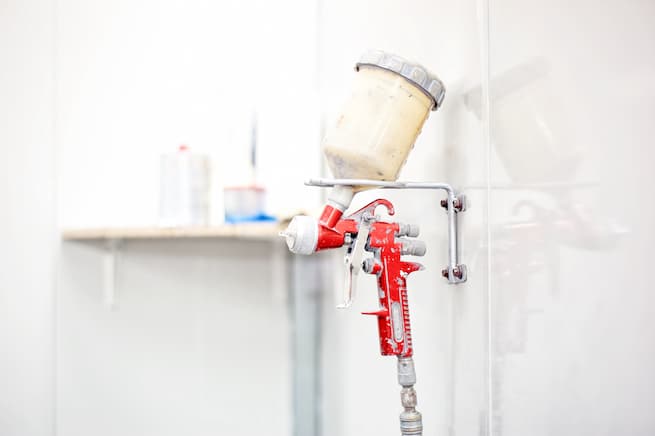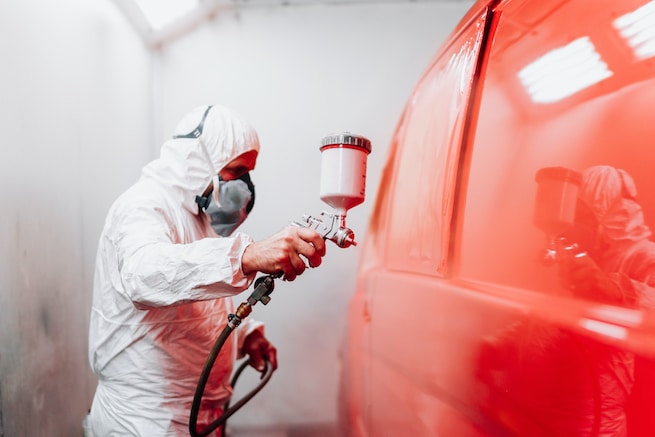7 Causes Explaining Why Is A Paint Sprayer Blowing Only Air
When using a paint gun, it can be frustrating and counterproductive if the sprayer is blowing only air without expelling any paint or coating. This issue can arise due to several factors.
But, why is a paint sprayer blowing only air? It could be a result of insufficient paint supply, a clogged nozzle or tip, improper paint viscosity, inadequate air pressure, faulty spray gun components, air leakage, or incorrect spray gun setup.
Troubleshooting and addressing these issues are crucial to ensure that the spray gun functions properly, allowing for efficient and effective paint application.
What is a Paint Gun or Sprayer and How it Works?

This device is used in spraying paint or other coatings onto surfaces. It is designed to atomize the paint into tiny particles and spray them onto the desired surface in a controlled manner.
An airless sprayer is commonly used in various industries and for different applications, including automotive refinishing, furniture restoration, residential painting, and commercial projects.
When using a paint gun, the primary function is to draw paint from a container or reservoir and deliver it to the surface being painted. The basic components of a paint gun include:
Motor or Compressor
Paint sprayers are powered by either an electric motor or an air compressor. The motor or compressor generates enough power and necessary pressure or airflow to propel the paint through the system.
Paint Container
Paint sprayers typically have a container or reservoir to hold the paint or coating. This can be in the form of a cup, a canister, or a separate container that connects to the sprayer.
Pump or Piston
The pump or piston mechanism in the sprayer draws the paint from the container and pressurizes it for spraying. It creates the required pressure to push the paint through the system.
Nozzle and Tip
The nozzle and tip play a crucial role in atomizing the paint into fine particles and controlling the exact size of the spray pattern. Different nozzle sizes and tip configurations are available to achieve desired spray patterns, such as circular, fan-shaped, or other variations.
Trigger or Control Mechanism
The spray gun’s trigger or control mechanism regulates the paint flow. When activated, it releases the pressurized paint and controls the volume and intensity of the spray.
Now, let’s explore how a paint gun works:
Paint Preparation
The paint or coating must be properly prepared before using a spray gun. This may involve thinning the paint with appropriate solvents or additives to achieve the desired viscosity for spraying. It is important to follow the manufacturer’s instructions regarding paint consistency.
Paint Transfer
The paint is transferred from the container into the sprayer system. This can be done through various methods, depending on the type of sprayer. Gravity-fed sprayers use gravity to feed the paint from a cup or container, while suction-fed sprayers draw the paint directly from a canister. Airless sprayers use a high-pressure pump or vacuum to force the paint into the system.
Atomization and Pressure
Once the paint is in the sprayer, it passes through the connection between the nozzle and tip. As the paint flows through the small orifice of the tip, it is atomized into tiny particles. The pressure generated by the motor or compressor creates the necessary force to propel the paint out of the sprayer.
Spray Pattern and Flow Control
The spray gun’s trigger or control mechanism regulates the paint flow. By controlling the trigger, the painter can adjust the sprayed volume. Additionally, by adjusting the nozzle and tip, the painter can control the spray pattern, whether a wide fan shape or a thin, concentrated stream.
Application
With the paint properly atomized and the desired spray pattern selected, the painter can apply the paint to the intended surface. The sprayer should be moved in a smooth, fluid, and consistent motion, maintaining an appropriate distance from the surface for even coverage.
By understanding the components and operation of a spray gun, users can achieve better control, efficiency, and quality in their painting projects. It is essential to follow the manufacturer’s instructions and safety guidelines to ensure safe and effective use of the paint gun.
The Importance of A Paint Gun Working Properly

A properly working spray gun is of utmost importance in achieving high-quality and efficient painting results. Here are some key reasons why a properly functioning spray gun is essential:
Quality Finish
A spray gun that is in good working condition ensures a smooth and professional finish. It atomizes the paint or coating into fine particles, allowing for even coverage and a uniform appearance. With a well-functioning sprayer, you can achieve a flawless finish that enhances the aesthetics of the painted surface.
Time and Cost Efficiency
Using a spray gun can significantly reduce painting time compared to traditional methods like brushes or rollers. A properly working sprayer allows for a faster application and better coverage, enabling you to complete projects more efficiently. This time-saving advantage can lead to cost savings, especially in large-scale or commercial painting projects.
Consistency and Uniformity
A functional spray gun helps maintain consistency and uniformity throughout the painting process. It ensures an even distribution of paint, minimizing color, texture, or thickness variations. This is particularly crucial when working on large surfaces or projects that require a cohesive and professional appearance.
Increased Productivity
A spray gun that operates properly can increase productivity by allowing painters to cover larger areas in less time. With the ability to adjust the spray pattern, a functional sprayer facilitates smooth and continuous application, reducing the need for frequent stops and reapplication.
Enhanced Coverage and Adhesion
A paint gun that functions well ensures better coverage and adhesion of the paint or coating to the surface being painted. Proper atomization and consistent pressure promote improved bonding, reducing the likelihood of peeling, chipping, or unevenness over time.
Maintaining and regularly inspecting your spray gun is essential to ensure its proper functioning. Follow the manufacturer’s guidelines for cleaning, maintenance, and troubleshooting to keep your sprayer in optimal condition and enjoy the benefits it offers in terms of efficiency, quality, and productivity.
Reasons Why Paint Sprayer Can Only Blow Air And Not Paint
If a spray gun only blows air without any paint or coating being expelled, there could be several possible reasons for this issue. Here are some common causes:
Insufficient Paint Supply
Check the paint supply and ensure enough paint is in the container or cup of the sprayer. If the paint level is too low, the sprayer may only expel air instead of paint.
Clogged Nozzle, Hose, or Spray Tip
Paint gun nozzles or tips or gun filter can become stuck or clogged with dried paint or debris, blocking the release of paint. You can fix this by inspecting the nozzle and clean it thoroughly to remove any obstructions.
Improper Paint Viscosity or Dried Paint
Paint that is too thick or has not been properly thinned may not flow properly through the sprayer. Ensure that the paint viscosity matches the manufacturer’s recommendations for the specific sprayer model.
Not Much Pressure
If the air pressure setting on the sprayer is too low, it may result in air being blown without any paint being expelled. Adjust the low pressure to the recommended level for the paint type.
Faulty Spray Gun Components
Check for any defects or malfunctions in the spray gun components, such as a damaged or worn-out needle, nozzle, or air cap. Replace any faulty parts as necessary.
Air Leakage Causing Bubbles
Inspect the spray gun and its connections for any air leaks. Air leaks can disrupt the spraying flow and cause the sprayer to blow only air. Tighten all connections and replace any worn-out seals or gaskets if needed.
Incorrect Spray Gun Setup
Ensure the spray gun is properly assembled and set up according to the manufacturer’s instructions. This is easily fixed by verifying that all components are in their correct positions and that adjustments are made correctly for the desired spray pattern.
Tips to Follow When Your Paint Gun Is Not Spraying Paint
When a spray gun is only blowing air without dispensing paint or coating, it can be frustrating and hinder your painting progress. Here are some subheadings that can help guide you in troubleshooting and resolving the issue:
Check the Paint Supply
Inspect the paint supply container: Ensure the paint container or cup is properly filled with paint or coating.
Check for blockages: Check for any clogs or blockages in the paint supply tube or needle chuck that may prevent the paint from reaching the sprayer.
Verify Proper Setup
Review the sprayer settings: Ensure the spray gun is set up correctly, including the proper air pressure and sprayer adjustments.
Confirm paint viscosity: Check if the paint or coating being used is properly thinned or adjusted to the appropriate viscosity for the sprayer. Thick or improperly thinned paint can lead to clogs.
Clean and Maintain the Sprayer
Clear the nozzle: Clean the spray gun nozzle using appropriate cleaning tools to remove any dried paint or debris that may be blocking the flow of paint. You can use soapy water to clean this part.
Check filters and screens: Inspect and clean any filters or screens in the sprayer system to ensure they are not obstructed or clogged.
Check Air Compressor
Confirm adequate air supply: Ensure that the air compressor supplying air to the spray gun functions properly and delivers sufficient pressure and airflow.
Check for air leaks: Inspect the air hoses, fittings, and connections for any leaks that could result in reduced air pressure reaching the sprayer.
Test with Different Nozzle or Spray Tip
Try a different nozzle or tip: Switching to a different size or type of nozzle or tip may help troubleshoot whether the issue lies with the specific spray tip being used.
Seek Professional Assistance
If the problem persists, it may be necessary to reach out to the manufacturer or supplier of the spray gun for troubleshooting advice or to seek professional repair services.
Remember safety precautions should always be followed, such as wearing appropriate personal protective equipment (PPE) and ensuring proper ventilation when working with paint or coating materials.
If none of these troubleshooting steps resolve the issue, it may be necessary to consult the sprayer’s user manual or contact the manufacturer’s customer support for further assistance. They can provide specific guidance based on the make and model of the paint spray gun.
Conclusion
Encountering a situation where a spray gun is blowing only air without expelling any paint or coating can be frustrating. However, it is a common issue that can be resolved by addressing various possible causes.
Make sure to test spray gun first to know if there is an air leak. Check the suction tube and other parts, like the airbrush cleaner, to ensure your unit works fine. A repair kit is available over the net.
Last Updated on: March 16, 2025

